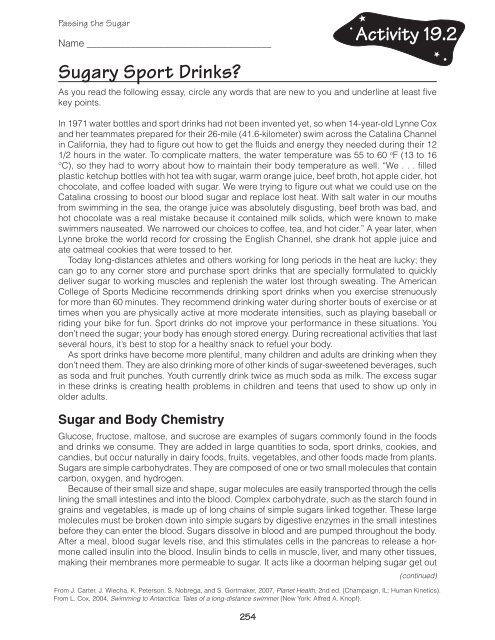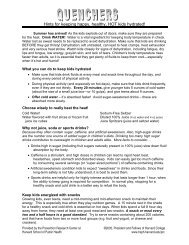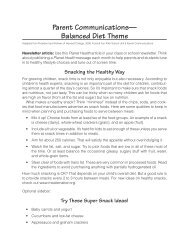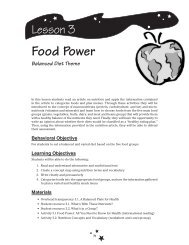Lesson 19: Passing the Sugar - Planet Health
Lesson 19: Passing the Sugar - Planet Health
Lesson 19: Passing the Sugar - Planet Health
Create successful ePaper yourself
Turn your PDF publications into a flip-book with our unique Google optimized e-Paper software.
<strong>Passing</strong> <strong>the</strong> <strong>Sugar</strong>Name ______________________________________<strong>Sugar</strong>y Sport Drinks?As you read <strong>the</strong> following essay, circle any words that are new to you and underline at least fivekey points.In <strong>19</strong>71 water bottles and sport drinks had not been invented yet, so when 14-year-old Lynne Coxand her teammates prepared for <strong>the</strong>ir 26-mile (41.6-kilometer) swim across <strong>the</strong> Catalina Channelin California, <strong>the</strong>y had to figure out how to get <strong>the</strong> fluids and energy <strong>the</strong>y needed during <strong>the</strong>ir 121/2 hours in <strong>the</strong> water. To complicate matters, <strong>the</strong> water temperature was 55 to 60 o F (13 to 16°C), so <strong>the</strong>y had to worry about how to maintain <strong>the</strong>ir body temperature as well. “We . . . filledplastic ketchup bottles with hot tea with sugar, warm orange juice, beef broth, hot apple cider, hotchocolate, and coffee loaded with sugar. We were trying to figure out what we could use on <strong>the</strong>Catalina crossing to boost our blood sugar and replace lost heat. With salt water in our mouthsfrom swimming in <strong>the</strong> sea, <strong>the</strong> orange juice was absolutely disgusting, beef broth was bad, andhot chocolate was a real mistake because it contained milk solids, which were known to makeswimmers nauseated. We narrowed our choices to coffee, tea, and hot cider.” A year later, whenLynne broke <strong>the</strong> world record for crossing <strong>the</strong> English Channel, she drank hot apple juice andate oatmeal cookies that were tossed to her.Today long-distances athletes and o<strong>the</strong>rs working for long periods in <strong>the</strong> heat are lucky; <strong>the</strong>ycan go to any corner store and purchase sport drinks that are specially formulated to quicklydeliver sugar to working muscles and replenish <strong>the</strong> water lost through sweating. The AmericanCollege of Sports Medicine recommends drinking sport drinks when you exercise strenuouslyfor more than 60 minutes. They recommend drinking water during shorter bouts of exercise or attimes when you are physically active at more moderate intensities, such as playing baseball orriding your bike for fun. Sport drinks do not improve your performance in <strong>the</strong>se situations. Youdon’t need <strong>the</strong> sugar; your body has enough stored energy. During recreational activities that lastseveral hours, it’s best to stop for a healthy snack to refuel your body.As sport drinks have become more plentiful, many children and adults are drinking when <strong>the</strong>ydon’t need <strong>the</strong>m. They are also drinking more of o<strong>the</strong>r kinds of sugar-sweetened beverages, suchas soda and fruit punches. Youth currently drink twice as much soda as milk. The excess sugarin <strong>the</strong>se drinks is creating health problems in children and teens that used to show up only inolder adults.<strong>Sugar</strong> and Body ChemistryGlucose, fructose, maltose, and sucrose are examples of sugars commonly found in <strong>the</strong> foodsand drinks we consume. They are added in large quantities to soda, sport drinks, cookies, andcandies, but occur naturally in dairy foods, fruits, vegetables, and o<strong>the</strong>r foods made from plants.<strong>Sugar</strong>s are simple carbohydrates. They are composed of one or two small molecules that containcarbon, oxygen, and hydrogen.Because of <strong>the</strong>ir small size and shape, sugar molecules are easily transported through <strong>the</strong> cellslining <strong>the</strong> small intestines and into <strong>the</strong> blood. Complex carbohydrate, such as <strong>the</strong> starch found ingrains and vegetables, is made up of long chains of simple sugars linked toge<strong>the</strong>r. These largemolecules must be broken down into simple sugars by digestive enzymes in <strong>the</strong> small intestinesbefore <strong>the</strong>y can enter <strong>the</strong> blood. <strong>Sugar</strong>s dissolve in blood and are pumped throughout <strong>the</strong> body.After a meal, blood sugar levels rise, and this stimulates cells in <strong>the</strong> pancreas to release a hormonecalled insulin into <strong>the</strong> blood. Insulin binds to cells in muscle, liver, and many o<strong>the</strong>r tissues,making <strong>the</strong>ir membranes more permeable to sugar. It acts like a doorman helping sugar get outFrom J. Carter, J. Wiecha, K. Peterson, S. Nobrega, and S. Gortmaker, 2007, <strong>Planet</strong> <strong>Health</strong>, 2nd ed. (Champaign, IL: Human Kinetics).From L. Cox, 2004, Swimming to Antarctica: Tales of a long-distance swimmer (New York: Alfred A. Knopf).254Activity <strong>19</strong>.2(continued)





